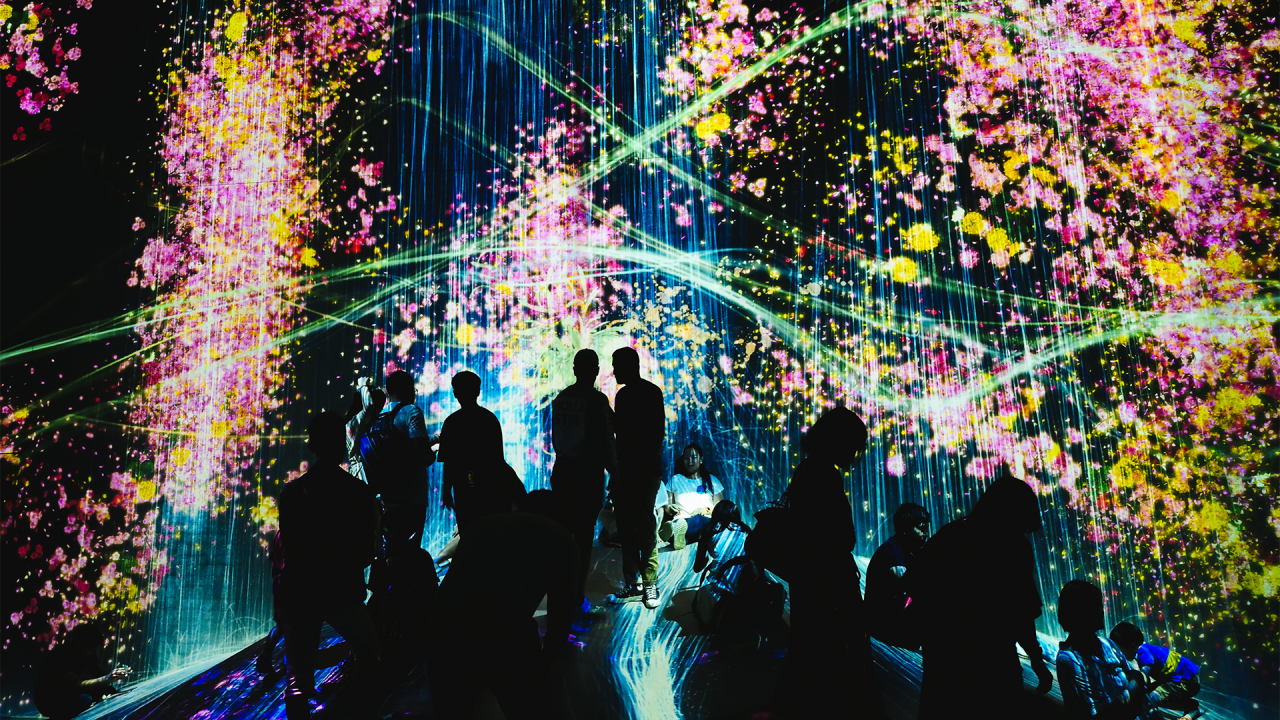
Key Takeaways:
- Projection mapping revolutionizes visual arts by transforming static objects and spaces into dynamic and immersive environments.
- Projection mapping redefines physical spaces, allowing for the transformation of ordinary locations into extraordinary and immersive environments.
- Projection mapping creates immersive experiences by seamlessly integrating projected visuals with physical surroundings, engaging multiple senses.
- Projection mapping techniques involve blend projectors, multisensory elements, and sophisticated mapping software to create realistic and captivating visuals.
- Projection mapping can be used in various applications such as live events, museums and galleries, and architectural showcases.
- The future of projection mapping includes more interactive experiences, the convergence with augmented reality, and potential applications in outer space.
The Rise of Projection Mapping
Revolutionizing Visual Arts
Projection mapping, also known as spatial augmented reality, has emerged as a groundbreaking technology in the world of visual arts. It has revolutionized the way we perceive and experience static objects and spaces by transforming them into dynamic and immersive environments.
The technique involves the projection of 3D imagery onto any surface, be it a building, stage, or even a simple object. By aligning the projected visuals with the physical features of the surface, projection mapping creates mesmerizing illusions that blur the line between reality and fiction.
With projection mapping, artists can breathe life into inanimate objects, turning them into interactive displays that captivate and engage audiences in ways never seen before.
Redefining Spaces
Projection mapping has also redefined the concept of physical spaces. It allows artists and designers to transform ordinary locations into extraordinary and immersive environments, turning them into canvases for creativity.
By manipulating the perception of space through precisely mapped visuals, projection mapping has the power to alter the dimensions and textures of any surface. It can make a small room appear vast, a plain wall come alive with vibrant colors, or a drab building facade morph into a dynamic piece of art.
This transformative technology has opened up a realm of possibilities for architects, event planners, and artists to redefine spaces and create unique experiences that engage and inspire audiences.
The Wow Factor: Creating Immersive Experiences
One of the most appealing aspects of projection mapping is its ability to create immersive experiences that leave a lasting impact on viewers. The seamless integration of projected visuals with physical surroundings creates a sense of wonder and enchantment.
Whether it’s a live performance, an art installation, or an advertising campaign, projection mapping captivates audiences by transporting them into alternative realities. It engages multiple senses, combining visuals, sound, and even motion to create a truly immersive experience that is both awe-inspiring and memorable.
By pushing the boundaries of traditional visual arts, projection mapping offers endless opportunities for artists and creatives to push the limits of their imagination and captivate audiences in ways never before possible.
Projection Mapping Techniques and Technologies
Blend Projectors and Reality
At the heart of projection mapping lie projectors that bring the digital world into the physical realm. These projectors play a crucial role in creating the illusion by precisely aligning the projected images with the surfaces they are mapping onto.
One of the key techniques employed in projection mapping is the use of multiple projectors to cover large and complex surfaces. By seamlessly blending the projected visuals, the boundaries between the real and the virtual are blurred, creating a unified and immersive experience.
The advancement of projection technology, such as high-resolution projectors and laser projectors, has significantly enhanced the quality and realism of projection mapping. These technological innovations allow for sharper and more vibrant visuals, further pushing the boundaries of what can be achieved with projection mapping.
Multisensory Magic: Incorporating Sound and Motion
While visuals play a central role in projection mapping, sound and motion are equally essential in creating a truly immersive experience. By incorporating synchronized audio and kinetic elements, projection mapping engages multiple senses, making the experience more captivating and memorable.
Sound can be used to enhance the narrative of the visuals by creating an emotional connection with the audience. It adds depth and dimension to the experience, making it more immersive and engaging.
Motion, on the other hand, adds another layer of dynamism to projection mapping. By incorporating moving parts or interactive elements, the projected visuals come to life, further blurring the boundaries between the virtual and the physical.
The Wizard Behind the Curtain: Mapping Software Demystified
Behind the captivating visuals of projection mapping is a sophisticated mapping software that enables artists and designers to bring their creative visions to life. This software plays a crucial role in aligning the projected images with the physical surfaces, ensuring a seamless and accurate mapping.
Mapping software uses complex algorithms to calculate the distortions and perspectives of the surfaces being mapped. It takes into account the shape, angles, and dimensions of the surfaces to ensure a precise alignment of the projected images.
With the advancement of mapping software, artists and designers now have access to user-friendly interfaces and intuitive tools that simplify the process of creating intricate and complex mapping designs. This accessibility has opened doors for a wider range of artists and creatives to experiment with projection mapping and push the boundaries of what is possible.
Unleashing Creativity: Applications of Projection Mapping
Transforming Live Events
Projection mapping has become a go-to technology for creating mesmerizing experiences at live events. From concerts and festivals to corporate conferences and product launches, projection mapping adds a new dimension to the event space, transforming ordinary venues into captivating stages.
With projection mapping, stage designs can be brought to life with dynamic visuals that complement the performances. The immersive nature of projection mapping allows artists to create seamless transitions between different scenes, enhancing the overall impact of the event.
Furthermore, projection mapping can be used to create interactive displays and installations at events, providing attendees with unique and memorable experiences. It allows for real-time interactions, enabling audiences to become active participants in the event.
Breathing Life into Museums and Galleries
Museums and galleries have embraced projection mapping as a means to breathe new life into their collections and exhibitions. By projecting visuals onto artifacts and artwork, projection mapping offers a fresh and dynamic way of presenting information and stories.
Projection mapping allows curators to go beyond traditional exhibition methods and create immersive environments that transport visitors into different eras or worlds. It enables them to contextualize the artwork, providing deeper insights and enhancing the visitors’ understanding of the pieces.
Additionally, projection mapping can be used to create interactive educational experiences, engaging visitors of all ages and making learning more enjoyable and memorable.
Architectural Wonders: Illuminating Buildings and Landmarks
Projection mapping has transformed the world of architecture by turning buildings and landmarks into mesmerizing works of art. By projecting visuals onto the facades of structures, projection mapping adds a new layer of storytelling and spectacle to the urban landscape.
Architectural projection mapping allows designers to highlight the unique features and history of a building, making it a focal point of admiration and curiosity. It can transform a mundane office building into a vibrant canvas that tells a story or pays homage to the local culture.
Furthermore, projection mapping can be used to create temporary installations and light shows on landmarks and monuments, adding a touch of magic and bringing communities together in moments of celebration.
The Future of Projection Mapping
Interactive Experiences: Engaging the Audience
The future of projection mapping lies in creating even more interactive experiences that fully engage the audience. Emerging technologies, such as motion sensors and gesture control, allow for real-time interactions between the viewers and the projected visuals.
Imagine a scenario where spectators can manipulate the projected visuals with their movements or even create custom visuals on the spot. This level of interactivity opens up endless possibilities for personalization and audience engagement, turning passive viewers into active participants.
Moreover, advancements in artificial intelligence and machine learning can further enhance the interactive capabilities of projection mapping. Smart systems can analyze data in real-time, adapting the visuals and narratives based on the audience’s reactions and preferences.
Augmented Reality and Projection Mapping: A Dynamic Duo
The convergence of augmented reality (AR) and projection mapping has the potential to revolutionize the way we interact with virtual and physical environments. By combining the real-time tracking capabilities of AR with the immersive visuals of projection mapping, a new dimension of storytelling and interactivity can be achieved.
AR-powered projection mapping enables virtual objects to seamlessly blend with physical surroundings, creating mixed reality experiences that are indistinguishable from the real world. It opens up opportunities for immersive gaming, educational simulations, and interactive retail experiences.
As AR technology continues to evolve and become more accessible, the integration of projection mapping will take these experiences to new heights, further blurring the boundaries between the virtual and the physical.
Taking Projection Mapping to Outer Space
While projection mapping has primarily been used on Earth, the future holds exciting possibilities for its application in outer space. Imagine a scenario where astronauts project visuals onto the surfaces of spacecraft or even onto celestial bodies.
Projection mapping in space exploration can serve both scientific and entertainment purposes. It can assist astronauts in navigation and exploration, providing them with useful information and enhancing their understanding of their surroundings.
Moreover, projection mapping can be used to create awe-inspiring performances and light shows in space, captivating audiences back on Earth and inspiring future generations to reach for the stars.
Projection mapping has revolutionized the world of visual arts by transforming spaces into captivating and immersive experiences. From its humble beginnings as a niche technique, it has now become a widely adopted technology that redefines how we interact with our surroundings. The future of projection mapping holds even more possibilities for innovation and creativity, opening up new realms of storytelling and interactivity. Whether it’s transforming live events, breathing life into museums, or creating architectural wonders, projection mapping continues to captivate audiences and push the limits of artistic expression.
FAQ
Question: What is projection mapping? Answer: Projection mapping is a groundbreaking technology in visual arts that transforms static objects and spaces into dynamic and immersive environments through the projection of 3D imagery onto any surface.
Question: How does projection mapping redefine physical spaces? Answer: Projection mapping redefines physical spaces by allowing artists and designers to transform ordinary locations into extraordinary and immersive environments. It manipulates the perception of space through precisely mapped visuals, altering dimensions and textures of surfaces.
Question: What are the key techniques and technologies used in projection mapping? Answer: Projection mapping techniques involve using blend projectors to cover large surfaces, multimedia elements like sound and motion, and sophisticated mapping software to align projected images accurately with physical surfaces.
Question: What are some applications of projection mapping? Answer: Projection mapping can be used in various applications such as live events, museums and galleries, and architectural showcases. It enhances stage designs, presents information in museums, and transforms buildings and landmarks into mesmerizing works of art.
Question: What is the future of projection mapping? Answer: The future of projection mapping includes more interactive experiences, the convergence with augmented reality, and potential applications in outer space. Advancements in technology will allow for real-time interactions, personalized visuals, and seamless blending of virtual and physical environments.








